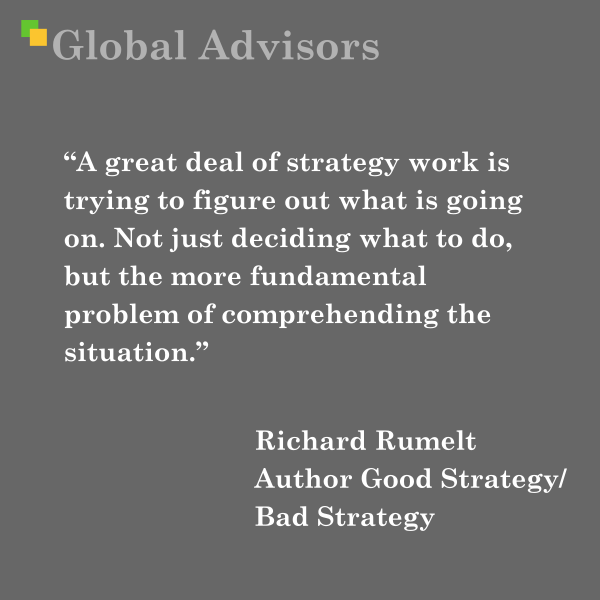“A great deal of strategy work is trying to figure out what is going on. Not just deciding what to do, but the more fundamental problem of comprehending the situation.” – Richard Rumelt, Good Strategy Bad Strategy: The Difference and Why It Matters
Richard Rumelt, one of the leading minds in strategic thinking, developed this insight after decades of research, teaching, and consulting with organizations across the globe. The quote distills what Rumelt observed as a recurring truth: the most critical—and often neglected—aspect of strategy isn’t picking a course of action, but genuinely understanding the situation at hand.
In Good Strategy/Bad Strategy, Rumelt emphasizes that all effective strategy begins with what he terms “diagnosis”—a process of peeling away surface symptoms to identify the underlying challenges or opportunities. He found that many organizations skip or rush this diagnosis phase, leaping to plans and solutions without a grounded understanding of what’s really driving results, difficulties, or change. This, in Rumelt’s view, leads to bad strategy: shallow, ineffectual plans that may look impressive but lack substance and direction.
Rumelt contrasts this with good strategy, which rests on a clear-eyed assessment of reality. He argues that good strategy cannot exist without grappling with the complex, ambiguous, and sometimes uncomfortable truths about an organization’s environment, resources, and constraints. This hard work of “figuring out what is going on” involves questioning assumptions, analyzing data, and challenging groupthink—activities that require intellectual honesty and often a willingness to confront inconvenient facts.
The quote also addresses a common misconception: that strategy is primarily about bold visions or ambitious goals. Rumelt insists that vision is no substitute for insight. Before deciding what to do, leaders must invest the necessary effort in comprehending their unique context. Only then can they design guiding policies and coherent actions that actually address the root causes of their challenges.
By highlighting the diagnostic foundation of strategy, Rumelt’s perspective has reshaped how leaders, teams, and organizations approach problem-solving. He champions the idea that identifying and framing the true nature of a challenge is the essential first step—without which, even the best-intended plans are likely to fall short.
About Richard Rumelt
Richard Rumelt is a distinguished scholar in the field of strategy, serving as professor emeritus at UCLA Anderson School of Management. His pioneering research and advisory work have influenced both academic thinking and practical approaches to strategic planning worldwide. Rumelt’s contributions are marked by his commitment to clarity, rigor, and the belief that strategic insight is achieved through disciplined analysis rather than wishful thinking.
Through his writing and teaching, Rumelt has demystified strategy, demonstrating that its strongest foundation lies not in rhetoric or aspiration, but in the clear comprehension of circumstances. His approach fosters not just effective strategies, but a culture of intellectual honesty and resilience—qualities essential for navigating complexity and driving lasting success




